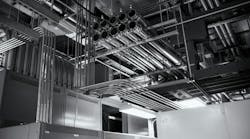Do you make any of these mistakes with personal protective equipment (PPE)?
- Treating PPE as your first line of defense. First reduce the hazards as much as practical, then choose the PPE that protects you in the reduced hazard situation.
- Assuming it has 100% integrity, rather than inspecting before each use. A pinhole in a rubber blanket or insulating glove can prove lethal. Climbing and fall protection gear are also prime examples of PPE that must be inspected before each use.
- Substituting what you have for what you actually need. If you don’t have the correct PPE, “close enough” won’t make you safe. Use the correct PPE or don’t do the work.
- Tossing it in the gang box, rather than putting it away properly. Items such as insulating gloves can easily be ruined by improper handling and storage.
- Using it incorrectly. Examples include wearing your hardhat with the bill to the back, wearing safety glasses on top of your head, and wearing colored lenses under the wrong conditions (e.g., amber lenses in daylight).
If so, it’s time to adjust your thinking.



